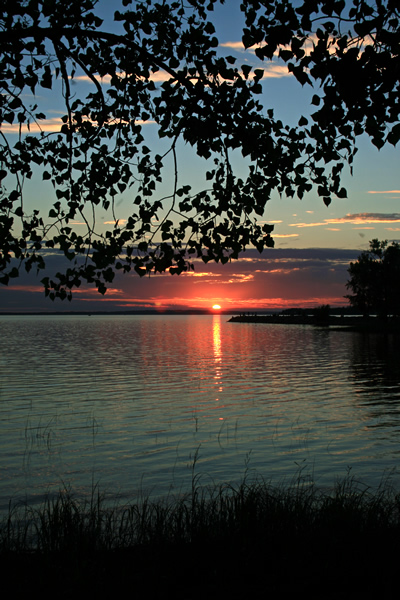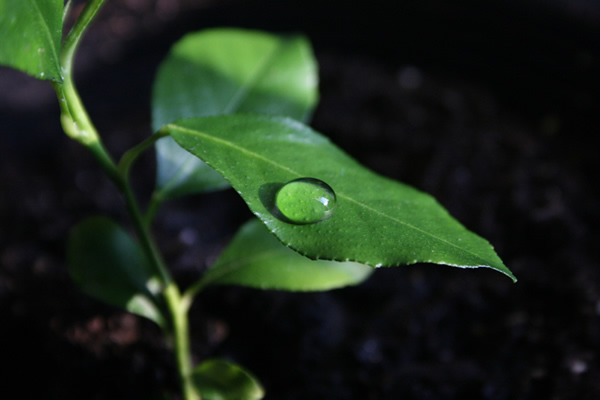
Tag: plant
Photo: Red Salvia on wine and green, June 13, 2012

Photo: Watercolour Kalanchoe, spring 2012
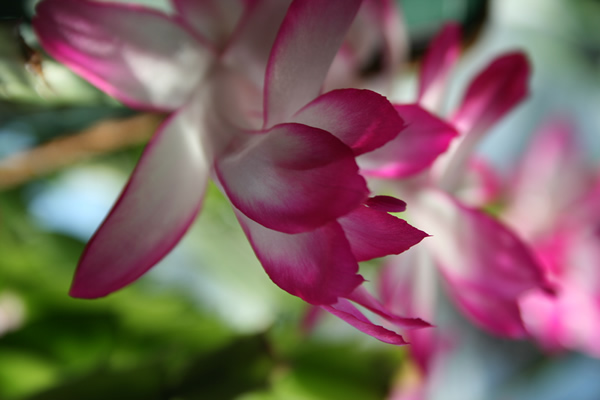
Photo: Tears of god, summer 2012

Photo: Ashen fern, summer 2011

Photo: Purple gramophones on green, June 13, 2012

Photo: Evergreen branches, spring 2012

Photo: Grapevine, June 13, 2012

Puzzle: Audubon – American Robin
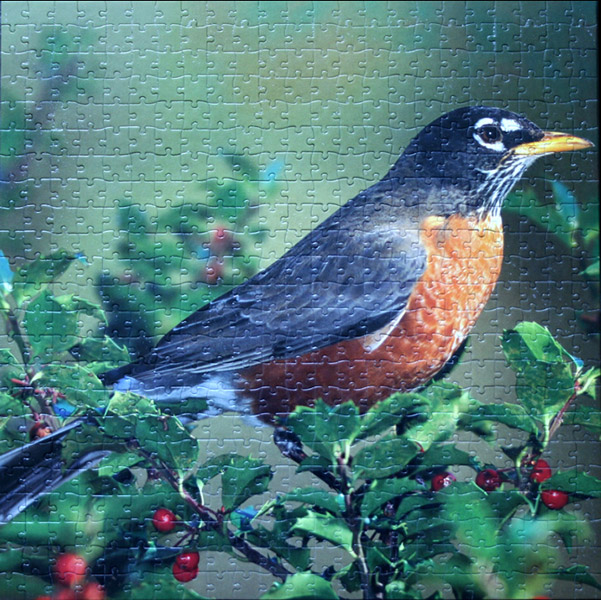
Size: 500 pieces
Dimensions: 45.72cm x 45.72cm
Producer: Buffalo Games
Box: photo
Photographer: Adam Jones
Notes: The American Robin or North American Robin (Turdus migratorius) is a migratory songbird of the thrush family. It is named after the European Robin[3] because of its reddish-orange breast, though the two species are not closely related, with the European robin belonging to the flycatcher family. The American Robin is widely distributed throughout North America, wintering south of Canada from Florida to central Mexico and along the Pacific Coast.
The American Robin is active mostly during the day and assembles in large flocks at night. Its diet consists of invertebrates (such as beetle grubs and caterpillars), fruits and berries. It is one of the earliest bird species to lay eggs, beginning to breed shortly after returning to its summer range from its winter range. Its nest consists of long coarse grass, twigs, paper, and feathers, and is smeared with mud and often cushioned with grass or other soft materials. It is among the first birds to sing at dawn, and its song consists of several discrete units that are repeated. [Wiki]
Puzzle: Audubon – Northern Cardinal
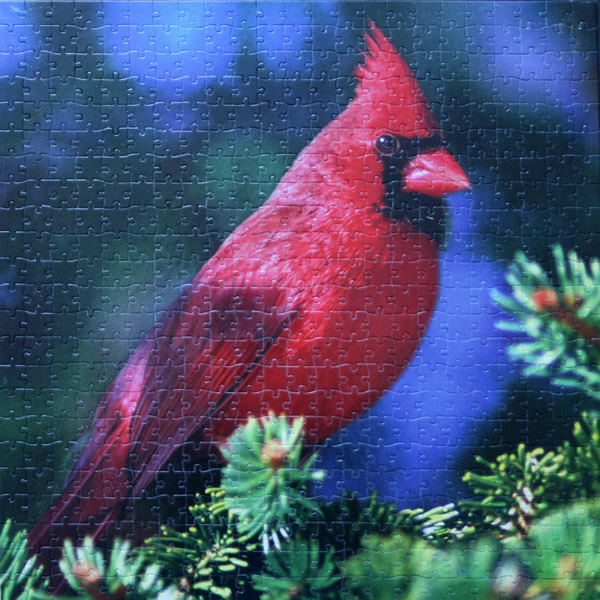
Size: 500 pieces
Dimensions: 45.72cm x 45.72cm
Producer: Buffalo Games
Box: photo
Photographer: Gene Stone / Leeson Photography
Notes: The Northern Cardinal (Cardinalis cardinalis) is a North American bird in the genus Cardinalis; it is also known colloquially as the redbird or common cardinal. It can be found in southern Canada, through the eastern United States from Maine to Texas and south through Mexico. It is found in woodlands, gardens, shrublands, and swamps.
The Northern Cardinal is a mid-sized songbird with a body length of 21 centimeters (8.3 inches). It has a distinctive crest on the head and a mask on the face which is black in the male and gray in the female. The male is a vibrant red, while the female is a dull red-brown shade. The Northern Cardinal is mainly granivorous, but also feeds on insects and fruit. The male behaves territorially, marking out his territory with song. During courtship, the male feeds seed to the female beak-to-beak. A clutch of three to four eggs is laid, and two to four clutches are produced each year. It was once prized as a pet, but its sale as cage birds is now banned in the United States by the Migratory Bird Treaty Act of 1918. [Wiki]
Puzzle: Cholmondeley Castle

Size: 1000 pieces
Dimensions: 73cm x 48.5cm
Producer: Sure-Lox, The Canadian Group
Notes: Cholmondeley Castle is a country house in the civil parish of Cholmondeley, Cheshire, England. It is surrounded by a 7,500 acres estate.
In the 18th century Hugh Cholmondeley, 1st Earl of Cholmondeley had created gardens around the house, both kitchen gardens and orchards to provide food for the household, and also pleasure gardens. The pleasure gardens would have been formal in style as they were laid out by George London. The ironworker Jean Tijou produced an iron entrance gate to the gardens, but this was moved to Houghton Hall in Norfolk by the 4th Earl. John van Nost designed a fountain for the garden. The garden also contained a bowling green and an aviary. The 4th Earl brought in William Emes to redesign the garden who, according to the fashion of the day, buried London’s work under a landscape park. [Wiki]
Puzzle: Forest Floor
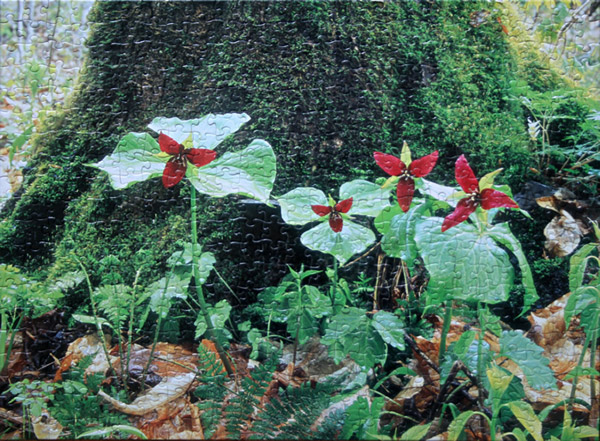
Size: 500 pieces
Dimensions: 48.26cm x 35.56cm
Producer: Sure-Lox, The Canadian Group
Notes: A forest, also referred to as a wood or the woods, is an area with a high density of trees. These plant communities cover approximately 9.4 percent of the Earth’s surface (or 30 percent of total land area), though they once covered much more (about 50 percent of total land area). Although forests are classified primarily by trees, the concept of a forest ecosystem includes additional species (such as smaller plants, fungi, bacteria, and animals) as well as physical and chemical processes such as energy flow and nutrient cycling.
A typical forest is composed of the overstory (canopy or upper tree layer) and the understory. The understory is further subdivided into the shrub layer, herb layer, and also the moss layer and soil microbes. In some complex forests, there is also a well-defined lower tree layer. Forests are central to all human life because they provide a diverse range of resources: they store carbon, aid in regulating the planetary climate, purify water and mitigate natural hazards such as floods. Forests also contain roughly 90 percent of the world’s terrestrial biodiversity. [Wiki]
Puzzle: Easter Lily

Size: 500 pieces
Dimensions: 48.26cm x 35.56cm
Producer: Sure-Lox, The Canadian Group
Notes: Lilium longiflorum, often called the Easter lily or November lily, is a plant native to the Ryukyu Islands (Japan) and Taiwan. It is a stem rooting lily, growing up to 1 m high. It bears a number of trumpet shaped, white, fragrant, and outward facing flowers.
From the 1890s to the early 1920s, there was a thriving export trade of bulbs from Bermuda to New York. A disease affected the Bermuda lilies: this was identified by Lawrence Ogilvie. Then most Easter lily bulbs arriving in the United States were imported from Japan before 1940s. The supply of bulbs was suddenly cut off after the attack on Pearl Harbor and Easter lilies became extremely valuable in the United States. [Wiki]
Puzzle: Iguazu Falls, Argentina
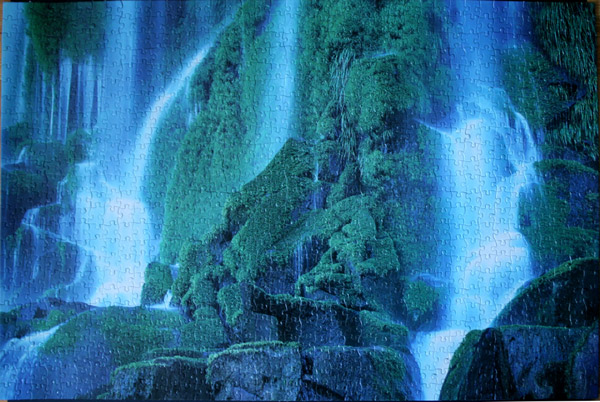
Size: 1000 pieces
Dimensions: 73cm x 48.6cm
Producer: The Canadian Group, Sure-Lox, Impressions
Notes: Iguazu Falls, Iguassu Falls, or Iguaçu Falls are waterfalls of the Iguazu River located on the border of the Brazilian State of Paraná and the Argentine Province of Misiones. The falls divide the river into the upper and lower Iguazu. The Iguazu River originates near the city of Curitiba. It flows through Brazil for most of its course. Below its confluence with the San Antonio River, the Iguazu River forms the boundary between Brazil and Argentina.
The name “Iguazu” comes from the Guarani or Tupi words y, meaning “water”, and ûasú, meaning “big”. Legend has it that a god planned to marry a beautiful woman named Naipí, who fled with her mortal lover Tarobá in a canoe. In rage the god sliced the river, creating the waterfalls and condemning the lovers to an eternal fall. The first European to find the falls was the Spanish Conquistador Álvar Núñez Cabeza de Vaca in 1541. [Wiki]
Photo: Winnipeg Water Levels, July 1, 2011

Photo: Sunny Lily, July 13, 2011
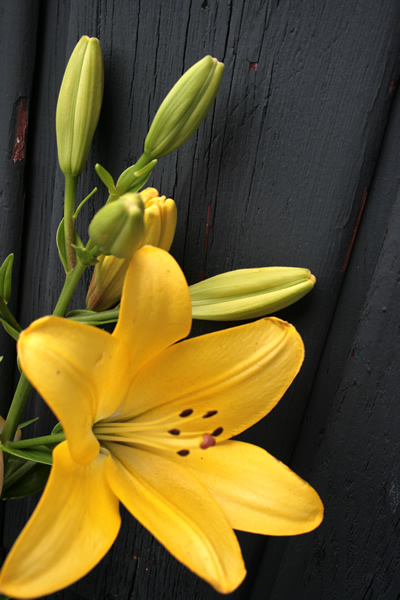
Photo: Purple Gramophones, July 1, 2011
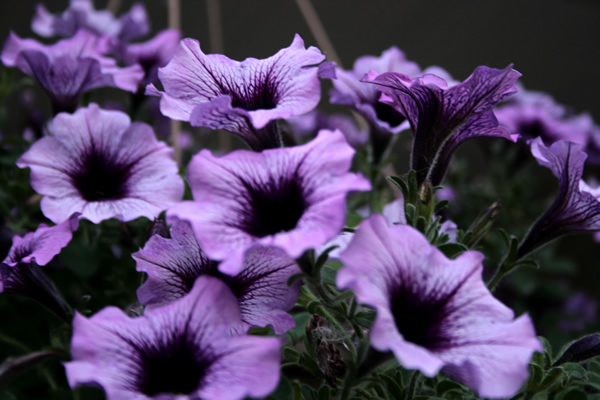
Photo: Raspberry Lily, July 1, 2011

Photo: Kaleidoscope, July 1, 2011

Photo: Sunset on Ottawa River, Canopy, July 16, 2011
